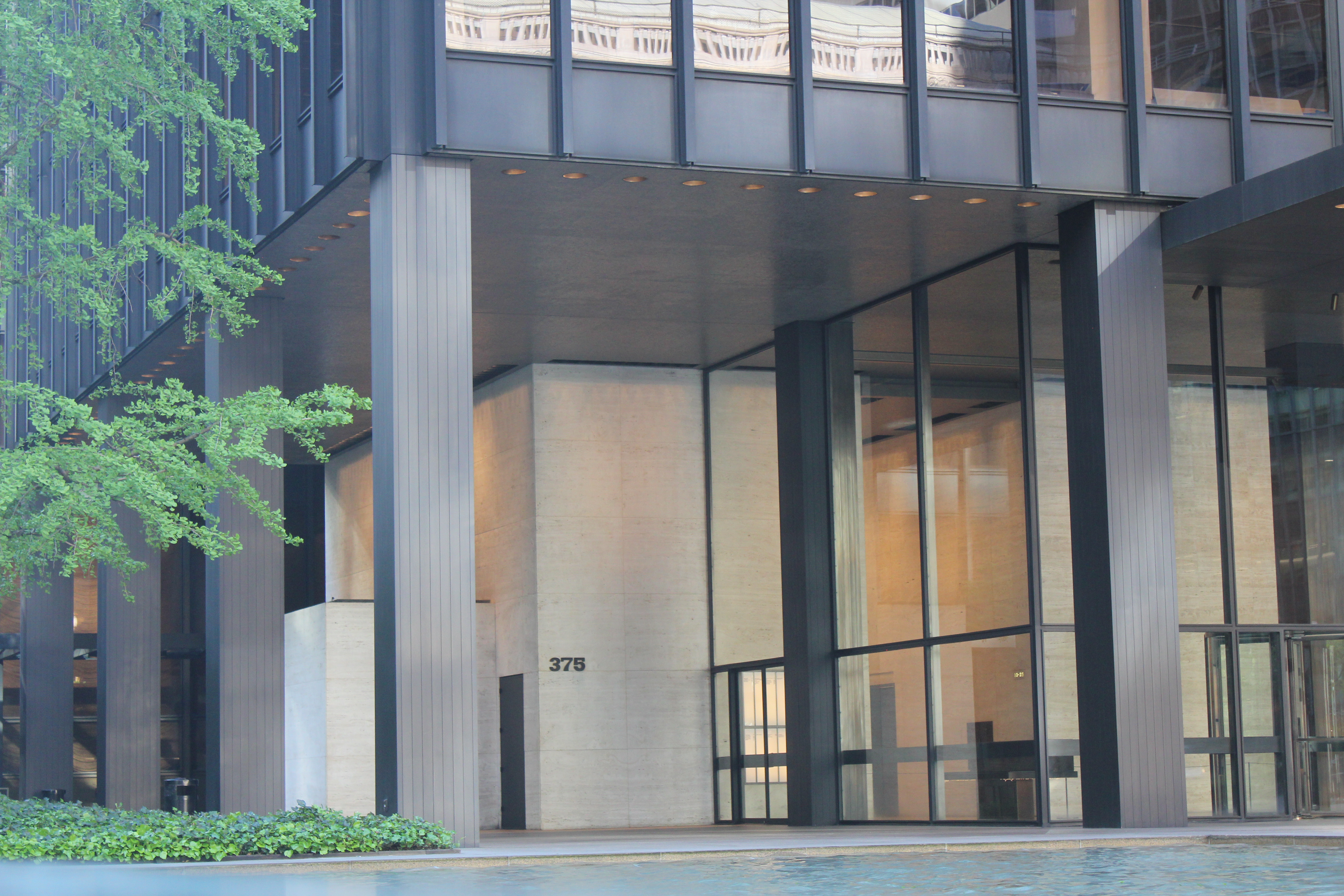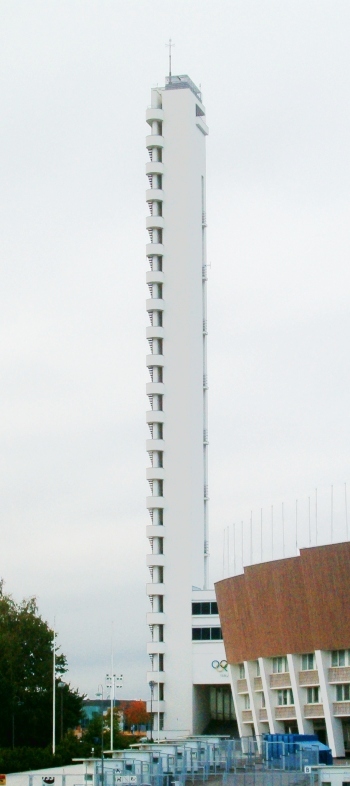|
Seagram Building
The Seagram Building is a skyscraper at 375 Park Avenue, between 52nd and 53rd Streets, in the Midtown Manhattan neighborhood of New York City. Designed by Ludwig Mies van der Rohe with minor assistance from Philip Johnson, Ely Jacques Kahn, and Robert Allan Jacobs, the tower is tall with 38 stories. The International Style building with a public plaza, completed in 1958, initially served as the headquarters of the Seagram Company, a Canadian distiller. Phyllis Lambert, daughter of Seagram CEO Samuel Bronfman, heavily influenced the Seagram Building's design, an example of the functionalist aesthetic and a prominent instance of corporate modern architecture. A glass curtain wall with vertical mullions of bronze and horizontal spandrels made of Muntz metal form the building's exterior. The pink granite plaza facing Park Avenue contains two fountains. Behind the plaza is a tall elevator lobby with a similar design to the plaza. The lowest stories originally contained the Fo ... [...More Info...] [...Related Items...] OR: [Wikipedia] [Google] [Baidu] |
Office
An office is a space where an Organization, organization's employees perform Business administration, administrative Work (human activity), work in order to support and realize objects and Goals, plans, action theory, goals of the organization. The word "office" may also denote a position within an organization with specific duties attached to it (see officer (other), officer, office-holder (other), office-holder, official); the latter is in fact an earlier usage, office as place originally referring to the location of one's duty. When used as an adjective, the term "office" may refer to business-related tasks. In legal, law, a company or organization has offices in any place where it has an official presence, even if that presence consists of (for example) a storage silo rather than an establishment with desk-and-office chair, chair. An office is also an architectural and design phenomenon: ranging from a small office such as a Bench (furniture), bench in th ... [...More Info...] [...Related Items...] OR: [Wikipedia] [Google] [Baidu] |
Robert Allan Jacobs
Robert Allan Jacobs (1905-1993) was an American architect and designer. He was the son of architect Harry Allan Jacobs. From 1940 to 1969, Jacobs collaborated with architect Ely Jacques Kahn in the firm of Kahn & Jacobs. He designed 100 Park Avenue, the Universal Pictures Building, 1407 Broadway, 425 Park Avenue, and the Municipal Asphalt Plant. In addition, he designed the Seagram Building in collaboration with Mies van der Rohe and Philip Johnson Philip Cortelyou Johnson (July 8, 1906 – January 25, 2005) was an American architect best known for his works of modern and postmodern architecture. Among his best-known designs are his modernist Glass House in New Canaan, Connecticut; the pos .... Jacobs retired from Kahn & Jacobs in 1973. References 1905 births 1993 deaths American architects American designers {{US-architect-stub ... [...More Info...] [...Related Items...] OR: [Wikipedia] [Google] [Baidu] |
Teachers Insurance And Annuity Association Of America
The Teachers Insurance and Annuity Association of America-College Retirement Equities Fund (TIAA, formerly TIAA-CREF), is a Fortune 100 financial services organization that is the leading provider of financial services in the academic, research, medical, cultural and governmental fields. TIAA serves over 5 million active and retired employees participating at more than 15,000 institutions and has $1 trillion in combined assets under management with holdings in more than 50 countries (). Profile Long organized as a tax-exempt non-profit organization, a 1997 tax bill removed TIAA's tax exemption. It is now organized as a non-profit organization, the TIAA Board of Governors, with taxable subsidiaries; all profits are returned to policyholders. TIAA bought its Manhattan headquarters building, 730 Third Avenue, in 1955. It has major offices in Denver, Colorado; Charlotte, North Carolina; and Dallas, Texas; as well as 70 local offices throughout the U.S. In 2018, TIAA ranked ... [...More Info...] [...Related Items...] OR: [Wikipedia] [Google] [Baidu] |
Pereira & Luckman
Pereira & Luckman was a Los Angeles, California architectural firm that partners Charles Luckman and William Pereira founded in Los Angeles in 1950. They had been classmates at the University of Illinois’ School of Architecture and had each become prominent thereafter, Pereira designing cinemas around the U.S. and a film studio for Paramount Pictures. The partnership eventually employed more than 300 architects. The firm is notable for having designed such landmarks in the Los Angeles area as the Theme Building at Los Angeles International Airport, CBS Television City and several J. W. Robinson's department stores, but also work for NASA, Hilton Hotels and many others. It employed Paul Williams. Works Source: *1951 ** Farmers & Stockmen's Bank, Phoenix, Arizona ** Gibraltar Savings & Loan Headquarters, Beverly Hills, California ** Robinson's department store, Beverly Hills (demolished) ** Robinson's department store, Pasadena, California * 1952 ** Avco Research Center, Wilming ... [...More Info...] [...Related Items...] OR: [Wikipedia] [Google] [Baidu] |
Modular Building
A modular building is a prefabricated building that consists of repeated sections called modules. Modularity involves constructing sections away from the building site, then delivering them to the intended site. Installation of the prefabricated sections is completed on site. Prefabricated sections are sometimes placed using a crane (machine), crane. The modules can be placed side-by-side, end-to-end, or stacked, allowing for a variety of configurations and styles. After placement, the modules are joined together using inter-module connections, also known as inter-connections. The inter-connections tie the individual modules together to form the overall building structure. Uses Modular buildings may be used for long-term, temporary or permanent facilities, such as construction camps, schools and classrooms, civilian and military housing, and industrial facilities. Modular buildings are used in remote and rural areas where conventional construction may not be reasonable or pos ... [...More Info...] [...Related Items...] OR: [Wikipedia] [Google] [Baidu] |
Muntz Metal
Muntz metal (also known as yellow metal) is an alpha-beta brass alloy composed of approximately 60% copper, 40% zinc and a trace of iron. It is named after George Fredrick Muntz, a metal-roller of Birmingham, England, who commercialised the alloy following his patent of 1832. The alloy must be worked hot and is used today for corrosion-resistant machine parts. Alpha-beta (also called duplex) metals contain both the α and β phases. The α phase refers to a crystal structure that is face-centered cubic, while the β phase is body-centered cubic. Its original application was as a replacement for copper sheathing on the bottom of boats, as it maintained the anti-fouling abilities of the pure copper at around two thirds of the price. It became the material of choice for this application and Muntz made his fortune. It was found that copper would gradually leach from the alloy in sea water, poisoning any organism that attempted to attach itself to a hull sheathed in the metal. Thus ... [...More Info...] [...Related Items...] OR: [Wikipedia] [Google] [Baidu] |
Spandrel
A spandrel is a roughly triangular space, usually found in pairs, between the top of an arch and a rectangular frame; between the tops of two adjacent arches or one of the four spaces between a circle within a square. They are frequently filled with decorative elements. Meaning There are four or five accepted and cognate meanings of the term ''spandrel'' in architectural and art history, mostly relating to the space between a curved figure and a rectangular boundary – such as the space between the curve of an arch and a rectilinear bounding moulding, or the wallspace bounded by adjacent arches in an arcade and the stringcourse or moulding above them, or the space between the central medallion of a carpet and its rectangular corners, or the space between the circular face of a clock and the corners of the square revealed by its hood. Also included is the space under a flight of stairs, if it is not occupied by another flight of stairs. In a building with more than one floor ... [...More Info...] [...Related Items...] OR: [Wikipedia] [Google] [Baidu] |
Bronze
Bronze is an alloy consisting primarily of copper, commonly with about 12–12.5% tin and often with the addition of other metals (including aluminium, manganese, nickel, or zinc) and sometimes non-metals, such as phosphorus, or metalloids such as arsenic or silicon. These additions produce a range of alloys that may be harder than copper alone, or have other useful properties, such as ultimate tensile strength, strength, ductility, or machinability. The three-age system, archaeological period in which bronze was the hardest metal in widespread use is known as the Bronze Age. The beginning of the Bronze Age in western Eurasia and India is conventionally dated to the mid-4th millennium BCE (~3500 BCE), and to the early 2nd millennium BCE in China; elsewhere it gradually spread across regions. The Bronze Age was followed by the Iron Age starting from about 1300 BCE and reaching most of Eurasia by about 500 BCE, although bronze continued to be much more widely used than it is in mod ... [...More Info...] [...Related Items...] OR: [Wikipedia] [Google] [Baidu] |
Mullion
A mullion is a vertical element that forms a division between units of a window or screen, or is used decoratively. It is also often used as a division between double doors. When dividing adjacent window units its primary purpose is a rigid support to the glazing of the window. Its secondary purpose is to provide structural support to an arch or lintel above the window opening. Horizontal elements separating the head of a door from a window above are called transoms. History Stone mullions were used in Armenian, Saxon and Islamic architecture prior to the 10th century. They became a common and fashionable architectural feature across Europe in Romanesque architecture, with paired windows divided by a mullion, set beneath a single arch. The same structural form was used for open arcades as well as windows, and is found in galleries and cloisters. In Gothic architecture windows became larger and arrangements of multiple mullions and openings were used, both for structure and ... [...More Info...] [...Related Items...] OR: [Wikipedia] [Google] [Baidu] |
Modern Architecture
Modern architecture, or modernist architecture, was an architectural movement or architectural style based upon new and innovative technologies of construction, particularly the use of glass, steel, and reinforced concrete; the idea that form should follow function ( functionalism); an embrace of minimalism; and a rejection of ornament. It emerged in the first half of the 20th century and became dominant after World War II until the 1980s, when it was gradually replaced as the principal style for institutional and corporate buildings by postmodern architecture. Origins File:Crystal Palace.PNG, The Crystal Palace (1851) was one of the first buildings to have cast plate glass windows supported by a cast-iron frame File:Maison François Coignet 2.jpg, The first house built of reinforced concrete, designed by François Coignet (1853) in Saint-Denis near Paris File:Home Insurance Building.JPG, The Home Insurance Building in Chicago, by William Le Baron Jenney (1884) File:Const ... [...More Info...] [...Related Items...] OR: [Wikipedia] [Google] [Baidu] |
Functionalism (architecture)
In architecture, functionalism is the principle that buildings should be designed based solely on their purpose and function. This principle is a matter of confusion and controversy within the profession, particularly in regard to modern architecture, as it is less self-evident than it first appears. The theoretical articulation of functionalism in buildings can be traced back to the Vitruvius, Vitruvian triad, where ''utilitas'' (variously translated as 'commodity', 'convenience', or 'utility') stands alongside ''firmitas'' (firmness) and ''venustas'' (beauty) as one of three classic goals of architecture. Functionalist views were typical of some Gothic Revival architecture, Gothic Revival architects. In particular, Augustus Welby Pugin wrote that "there should be no features about a building which are not necessary for convenience, construction, or propriety" and "all ornament should consist of enrichment of the essential construction of the building". In the wake of World War ... [...More Info...] [...Related Items...] OR: [Wikipedia] [Google] [Baidu] |
Samuel Bronfman
Samuel Bronfman, (February 27, 1889 – July 10, 1971) was a Canadian businessman and philanthropist. He founded Distillers Corporation Limited, and is a member of the Canadian Bronfman family. Biography Samuel Bronfman was born in Otaci, Soroca uyezd, Bessarabia, then part of the Russian Empire (present-day Moldova), one of eight children of Mindel and Yechiel Bronfman. He and his parents were both Jewish refugees of Czarist Russia's antisemitic pogroms,Michael R. Marrus (1992). ''Samuel Bronfman: The Life and Times of Seagram's Mr. Sam'' who emigrated to Wapella in the North-West Territories' District of Assiniboia. They soon moved to Brandon, Manitoba. A wealthy family, they were accompanied by their rabbi and two servants. Soon Yechiel learned that tobacco farming, which had made him a wealthy man in his homeland, was incompatible with the cold climate of that region. Yechiel was forced to work as a laborer for the Canadian Northern Railway, and after a short time moved to ... [...More Info...] [...Related Items...] OR: [Wikipedia] [Google] [Baidu] |







